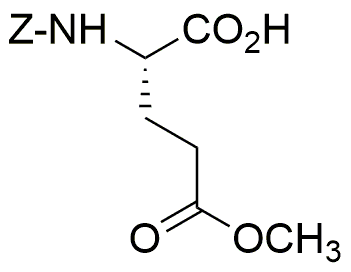Z-L-glutamic acid g-methyl ester is widely utilized in research focused on:
- Peptide Synthesis: This compound serves as a valuable building block in the synthesis of peptides, particularly in the development of pharmaceuticals and biologically active compounds.
- Neurotransmitter Research: It plays a role in studies related to neurotransmitter activity, especially in understanding the functions of glutamate in the nervous system, which is crucial for neurological research.
- Drug Development: The compound is used in the formulation of drugs targeting various conditions, including neurodegenerative diseases, due to its ability to mimic natural amino acids.
- Biochemical Assays: Researchers utilize it in biochemical assays to study enzyme activity and protein interactions, providing insights into metabolic pathways.
- Food Industry Applications: It can be used as a flavor enhancer in food products, capitalizing on its umami taste profile, which appeals to food scientists and manufacturers.
General Information
Properties
Safety and Regulations
Applications
Z-L-glutamic acid g-methyl ester is widely utilized in research focused on:
- Peptide Synthesis: This compound serves as a valuable building block in the synthesis of peptides, particularly in the development of pharmaceuticals and biologically active compounds.
- Neurotransmitter Research: It plays a role in studies related to neurotransmitter activity, especially in understanding the functions of glutamate in the nervous system, which is crucial for neurological research.
- Drug Development: The compound is used in the formulation of drugs targeting various conditions, including neurodegenerative diseases, due to its ability to mimic natural amino acids.
- Biochemical Assays: Researchers utilize it in biochemical assays to study enzyme activity and protein interactions, providing insights into metabolic pathways.
- Food Industry Applications: It can be used as a flavor enhancer in food products, capitalizing on its umami taste profile, which appeals to food scientists and manufacturers.
Documents
Safety Data Sheets (SDS)
The SDS provides comprehensive safety information on handling, storage, and disposal of the product.
Product Specification (PS)
The PS provides a comprehensive breakdown of the product’s properties, including chemical composition, physical state, purity, and storage requirements. It also details acceptable quality ranges and the product's intended applications.
Certificates of Analysis (COA)
Search for Certificates of Analysis (COA) by entering the products Lot Number. Lot and Batch Numbers can be found on a product’s label following the words ‘Lot’ or ‘Batch’.
*Catalog Number
*Lot Number
Certificates Of Origin (COO)
This COO confirms the country where the product was manufactured, and also details the materials and components used in it and whether it is derived from natural, synthetic, or other specific sources. This certificate may be required for customs, trade, and regulatory compliance.
*Catalog Number
*Lot Number
Safety Data Sheets (SDS)
The SDS provides comprehensive safety information on handling, storage, and disposal of the product.
DownloadProduct Specification (PS)
The PS provides a comprehensive breakdown of the product’s properties, including chemical composition, physical state, purity, and storage requirements. It also details acceptable quality ranges and the product's intended applications.
DownloadCertificates of Analysis (COA)
Search for Certificates of Analysis (COA) by entering the products Lot Number. Lot and Batch Numbers can be found on a product’s label following the words ‘Lot’ or ‘Batch’.
*Catalog Number
*Lot Number
Certificates Of Origin (COO)
This COO confirms the country where the product was manufactured, and also details the materials and components used in it and whether it is derived from natural, synthetic, or other specific sources. This certificate may be required for customs, trade, and regulatory compliance.


